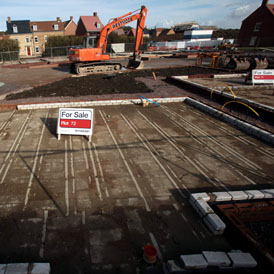Is new government help for housing constructive?
As the government announces more measures to coax the housing market into life, an expert tells Channel 4 News the move misses the real problem – house prices are too high.

Britain’s housing crisis is well-documented: a chronic shortage of homes paired with house prices that are far beyond the reach of many buyers – not just those getting onto the housing ladder (the government estimates there are 2.9 million people currently renting who aspire to buy their own home).
State aid so far has focused on helping people buy into the current market, where the average house price in England and Wales is £162,109 – just over six times the average salary of £25,900.
In his March budget, George Osborne announced £400m of help for first-time buyers via the government’s First Buy Scheme, essentially a subsidised loan-with-strings for those who can afford a 5 per cent deposit on new-build properties costing less than £280,000.
We must confront the inflationary psychology which means well-intentioned government interventions are helping to keep house prices unaffordable for the many. Prof Mark Stephens
The new scheme aims to provide capital to help builders to build new homes while encouraging potential first-time buyers to buy them. To insure against losses on properties, developers will post a deposit equal to 3.5 per cent of the value of the property.
The government is promising to pay 5.5 per cent of the value of a property in the scheme if losses are above the 3.5 per cent mark. At most, lenders could claim 95 per cent of the losses from any property in the fund, though the Council for Mortgage Lenders told Channel 4 News these would probably be “relatively small amounts”.
But is providing the means for people to buy into the current market a constructive policy?
Marginal help
Mark Stephens, professor in urban economics at the University of Glasgow, told Channel 4 News the measures may not actually help many people: “I think the measure will only be of marginal help to first time-buyers. It will only help those who can service 95-100 per cent mortgages, i.e. the better off.
“Remember that high LTV (loan to value) mortgages were becoming less common in the boom, not because lenders wouldn’t lend but because first-time buyers couldn’t afford to service them.”
Announcing the new package of help, David Cameron said he wants everyone to be able to own their home: “You always remember that moment, if you’ve done it, when you get that key and you walk into your first flat. It’s a magic moment. It’s a moment I want everyone in this country to have, not just better-off people.
“The dream of home ownership is something that should be achievable for everyone.”

But Prof Stephens thinks the coalition’s help may actually make the basic situation, that of unaffordability, worse: “The government is failing to confront the fundamental problem, which is that house prices are still too high.
“We might expect house prices to earnings to rise over time as people can afford to devote more of their income to housing – but the income growth from the late 90s doesn’t justify the step change that occurred.
“We simply must confront the inflationary psychology that still prevails in the housing market, which means that well-intentioned government interventions are really helping to keep house prices unaffordable for the many whilst providing assistance only for the few.”
Insurance
The question of who provides insurance for the loans should the market fall (and there has been news from property website Rightmove that sellers are starting to accept lower prices) has raised eyebrows, especially since in 2008 the governor of the Bank of England, Mervyn King, signalled his opposition to the change.
Mark Stephens said there should be a return to the practice of lenders providing their own insurance against losses: “For decades up to the late 1990s lenders operated their own mortgage indemnity insurance model to protect themselves against potential losses on high loan-to-value mortgages.
“The housing crash of the early 90s saw insurers face huge payouts on these policies, but they almost certainly stopped some lenders from going under.
“Insurers re-priced and insisted the lenders should carry some of the risk, but lenders convinced themselves that they weren’t really needed in the next housing boom, and they were competed out of the system.
“What I can’t understand is why the government – or the FSA – can’t simply make indeminity insurance compulsory on large loans and regulate the pricing and design of the products to protect consumers. Value for money could be achieved by organising this on a wholesale (rather than retail) basis.”
In response to Prof Stephens’s comments, the Department for Communities and Local Government issued the following statement –
“Today’s announcement will offer aspiring first-time buyers an alternative to scrimping and saving for that much-needed deposit by offering the option of 95 per cent loan-to-value mortgages at affordable rates.
“That is why the Home Builders Federation have said that this scheme will allow people to buy their new home on realistic terms, help in particular hard-pressed first time buyers, and will also be a huge boost to house building.
“The Council of Mortgage Lenders have also said that ‘This scheme is good news for home-buyers, developers and indeed the UK economy.’
“Ministers have been clear that they will back the aspirations of anyone wanting to get on the housing ladder, which is why earlier this year the government launched the FirstBuy scheme, which offers a valuable alternative for lower income buyers.”